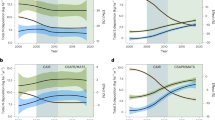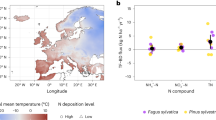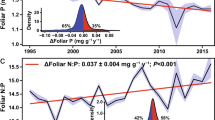Abstract
Atmospheric nitrogen and sulfur pollution increased over much of the United States during the twentieth century from fossil fuel combustion and industrial agriculture. Despite recent declines, nitrogen and sulfur deposition continue to affect many plant communities in the United States, although which species are at risk remains uncertain. We used species composition data from >14,000 survey sites across the contiguous United States to evaluate the association between nitrogen and sulfur deposition and the probability of occurrence for 348 herbaceous species. We found that the probability of occurrence for 70% of species was negatively associated with nitrogen or sulfur deposition somewhere in the contiguous United States (56% for N, 51% for S). Of the species, 15% and 51% potentially decreased at all nitrogen and sulfur deposition rates, respectively, suggesting thresholds below the minimum deposition they receive. Although more species potentially increased than decreased with nitrogen deposition, increasers tended to be introduced and decreasers tended to be higher-value native species. More vulnerable species tended to be shorter with lower tissue nitrogen and magnesium. These relationships constitute predictive equations to estimate critical loads. These results demonstrate that many herbaceous species may be at risk from atmospheric deposition and can inform improvements to air quality policies in the United States and globally.
This is a preview of subscription content, access via your institution
Access options
Access Nature and 54 other Nature Portfolio journals
Get Nature+, our best-value online-access subscription
$29.99 / 30 days
cancel any time
Subscribe to this journal
Receive 12 digital issues and online access to articles
$119.00 per year
only $9.92 per issue
Buy this article
- Purchase on Springer Link
- Instant access to full article PDF
Prices may be subject to local taxes which are calculated during checkout




Similar content being viewed by others
Data availability
The datasets generated during and/or analysed during the current study are available in the EPA Environmental Dataset Gateway repository (https://edg.epa.gov/metadata/catalog/main/home.page) at https://doi.org/10.23719/1500914.
References
Sala, O. E. et al. Global biodiversity scenarios for the year 2100. Science 287, 1770–1774 (2000).
Bobbink, R. et al. Global assessment of nitrogen deposition effects on terrestrial plant diversity: a synthesis. Ecol. Appl. 20, 30–59 (2010).
Sullivan, T. J. et al. Effects of acidic deposition and soil acidification on sugar maple trees in the Adirondack Mountains, New York. Environ. Sci. Technol. 47, 12687–12694 (2013).
Bowman, W. D., Cleveland, C. C., Halada, L., Hresko, J. & Baron, J. S. Negative impact of nitrogen deposition on soil buffering capacity. Nat. Geosci. 1, 767–770 (2008).
Throop, H. L. & Lerdau, M. T. Effects of nitrogen deposition on insect herbivory: implications for community and ecosystem processes. Ecosystems 7, 109–133 (2004).
Hautier, Y., Niklaus, P. A. & Hector, A. Competition for light causes plant biodiversity loss after eutrophication. Science 324, 636–638 (2009).
Clark, C. M. & Tilman, D. Loss of plant species after chronic low-level nitrogen deposition to prairie grasslands. Nature 451, 712–715 (2008).
Gilliam, F. S. et al. Twenty‐five‐year response of the herbaceous layer of a temperate hardwood forest to elevated nitrogen deposition. Ecosphere 7, e01250 (2016).
Driscoll, C. T. et al. Nitrogen pollution in the northeastern United States: sources, effects, and management options. Bioscience 53, 357–374 (2003).
Schaberg, P. G. et al. Effects of chronic N fertilization on foliar membranes, cold tolerance, and carbon storage in montane red spruce. Can. J. For. Res. 32, 1351–1359 (2002).
Burns, D. A., Lynch, J. A., Cosby, B. J., Fenn, M. E. & Baron, J. S. National Acid Precipitation Assessment Program Report to Congress 2011: An Integrated Assessment (US EPA Clean Air Markets Division, 2011).
Total Deposition 2015 Annual Map Summary NADP Data Report 2016-02 (National Atmospheric Deposition Program, 2016).
Clark, C. M. et al. Atmospheric deposition and exceedances of critical loads from 1800−2025 for the conterminous United States. Ecol. Appl. 28, 978–1002 (2018).
Houlton, B. Z. et al. Intentional versus unintentional nitrogen use in the United States: trends, efficiency and implications. Biogeochemistry 114, 11–23 (2013).
Li, Y. et al. Increasing importance of deposition of reduced nitrogen in the United States. Proc. Natl Acad. Sci. USA 113, 5874–5879 (2016).
Pardo, L. H. et al. Effects of nitrogen deposition and empirical nitrogen critical loads for ecoregions of the United States. Ecol. Appl. 21, 3049–3082 (2011).
Baron, J. S., Driscoll, C. T., Stoddard, J. L. & Richer, E. E. Empirical critical loads of atmospheric nitrogen deposition for nutrient enrichment and acidification of sensitive US lakes. BioScience 61, 602–613 (2011).
Ellis, R. A. et al. Present and future nitrogen deposition to national parks in the United States: critical load exceedances. Atmos. Chem. Phys. 13, 9083–9095 (2013).
Bobbink, R. & Hettelingh, J.-P. (eds.) Proc. of an Expert Workshop: Review and revision of empirical critical loads and dose-response relationships (Netherlands National Institute for Public Health and the Environment, 2011).
Payne, R. J., Dise, N. B., Stevens, C. J., Gowing, D. J. & Partners, B. Impact of nitrogen deposition at the species level. Proc. Natl Acad. Sci. USA 110, 984–987 (2013).
Wilkins, K., Aherne, J. & Bleasdale, A. Vegetation community change points suggest that critical loads of nutrient nitrogen may be too high. Atmos. Environ. 146, 324–331 (2016).
Simkin, S. M. et al. Conditional vulnerability of plant diversity to atmospheric nitrogen deposition across the United States. Proc. Natl Acad. Sci. USA 113, 4086–4091 (2016).
Vitousek, P. M. & Howarth, R. W. Nitrogen limitation on land and in the sea—how can it occur?. Biogeochemistry 13, 87–115 (1991).
Tilman, D. Constraints and tradeoffs: toward a predictive theory of competition and succession. Oikos 58, 3–15 (1990).
Belyazid, S. et al. A dynamic modelling approach for estimating critical loads of nitrogen based on plant community changes under a changing climate. Environ. Pollut. 159, 789–801 (2011).
Bobbink, R., M. Ashmore, S. Braun, S., Flückiger, W. and Van den Wyngaert, I. J. J. Empirical Nitrogen Critical Loads for Natural and Semi-natural Ecosystems: 2002 Update 40–170 (SAEFL, 2003).
Driscoll, C. T. et al. Acidic deposition in the northeastern United States: sources and inputs, ecosystem effects, and management strategies. BioScience 51, 180–198 (2001).
Garrison, M. T., Moore, J. A., Shaw, T. M. & Mika, P. G. Foliar nutrient and tree growth response of mixed-conifer stands to three fertilization treatments in northeast Oregon and north central Washington. Ecol. Manag. 132, 183–198 (2000).
Crowley, K. et al. Do nutrient limitation patterns shift from nitrogen toward phosphorus with increasing nitrogen deposition across the northeastern United States? Ecosystems 15, 940–957 (2012).
Goswami, S. et al. Phosphorus limitation of aboveground production in northern hardwood forests. Ecology 99, 438–449 (2018).
Kovar, J. L. & Karlen, D. L. In Proc. 19th World Congress of Soil Science; Soil Solutions for a Changing World (eds Gilkes, R. & Rakongkep, N.) 122–155 (International Union of Soil Sciences, 2010).
Clark, C. M. et al. Environmental and plant community determinants of species loss following nitrogen enrichment. Ecol. Lett. 10, 596–607 (2007).
Perring, M. P. et al. Understanding context dependency in the response of forest understorey plant communities to nitrogen deposition. Environ. Pollut. 242, 1787–1799 (2018).
Stevens, C. J. et al. Nitrogen deposition threatens species richness of grasslands across Europe. Environ. Pollut. 158, 2940–2945 (2010).
Swink, F. & Wilhelm, G. Plants of the Chicago Region 4th edn (Indiana Academy of Science, 1994).
Suding, K. N. et al. Functional- and abundance-based mechanisms explain diversity loss due to N fertilization. Proc. Natl Acad. Sci. USA 102, 4387–4392 (2005).
Aerts, R. & Chapin III, F. S. The mineral nutrition of wild plants revisited: a re-evaluation of processes and patterns. Adv. Ecol. Res. 30, 1–67 (1999).
Kirkby, E. A. in Marschner’s Mineral Nutrition of Higher Plants Foreword v–vi (Academic Press, 2012).
Wright, I. J. et al. The worldwide leaf economics spectrum. Nature 428, 821–827 (2004).
Holm, S. A simple sequentially rejective multiple test procedure. Scand. J. Statist. 6, 65–70 1979).
Mountford, J. O., Lakhani, K. H. & Kirkham, F. W. Experimental assessment of the effects of nitrogen addition under hay-cutting and aftermath grazing on the vegetation of meadows on a Somerset peat moor. J. Appl. Ecol. 30, 321–332 (1993).
Bai, Y. et al. Tradeoffs and thresholds in the effects of nitrogen addition on biodiversity and ecosystem functioning: evidence from inner Mongolia Grasslands. Glob. Change Biol. 16, 358–372 (2010).
Silvertown, J. et al. The Park Grass Experiment 1856-2006: Its contribution to ecology. J. Ecol. 94, 801–814 (2006).
Maskell, L. C., Smart, S. M., Bullock, J. M., Thompson, K. & Stevens, C. J. Nitrogen deposition causes widespread loss of species richness in British habitats. Glob. Change Biol. 16, 671–679 (2010).
Smart, S. M. et al. Large-scale changes in the abundance of common higher plant species across Britain between 1978, 1990 and 1998 as a consequence of human activity: Tests of hypothesised changes in trait representation. Biol. Conserv. 124, 355–371 (2005).
Dupre, C. et al. Changes in species richness and composition in European acidic grasslands over the past 70 years: the contribution of cumulative atmospheric nitrogen deposition. Glob. Change Biol. 16, 344–357 (2010).
De Vries, W. et al. Use of dynamic soil–vegetation models to assess impacts of nitrogen deposition on plant species composition: an overview. Ecol. Appl. 20, 60–79 (2010).
Integrated Science Assessment for Oxides of Nitrogen, Oxides of Sulfur and Particulate Matter: Ecological Criteria EPA/600/R-16/372 (EPA, 2017).
Daly, C. et al. Physiographically sensitive mapping of climatological temperature and precipitation across the conterminous United States. Int. J. Climatol. 28, 2031–2064 (2008).
Schwede, D. & Lear, G. A novel hybrid approach for estimating total deposition in the United States. Atmos. Environ. 92, 207–220 (2014).
Grossman D. H., et al. International Classification of Ecological Communities: Terrestrial Vegetation of the United States The National Vegetation Classification System: Development, Status, and Applications Vol. 1 (The Nature Conservancy, 1998).
National Atmospheric Deposition Program (NADP, accessed October 2018); http://nadp.sws.uiuc.edu/.
Burnham, K. A. D. A. Model Selection and Multimodel inference (Springer, 2002).
O’brien, R. M. A caution regarding rules of thumb for variance inflation factors. Qual. Quant. 41, 673–690 (2007).
Nilsson, J. A. G. P. E. Critical Loads for Sulfur and Nitrogen Report 1988:15 (Nordic Council of Ministers, 1988).
Freyman, W. A., Masters, L. A. & Packard, S. The Universal Floristic Quality Assessment (FQA) Calculator: an online tool for ecological assessment and monitoring. Methods Ecol. Evol. 7, 380–383 (2016).
Kattge, J. et al. TRY—a global database of plant traits. Glob. Change Biol. 17, 2905–2935 (2011).
PLANTS Database (US Department of Agriculture, accessed 10 June 2018); http://plants.usda.gov
Stevens, C. J., Wilson, J. & McAllister, H. A. Biological flora of the British Isles: Campanula rotundifolia. J. Ecol. 100, 821–839 (2012).
Acknowledgements
We thank J. T. Smith, S. Leduc and J. Compton for commenting on earlier versions of this manuscript, as well as the NADP Critical Loads of Atmospheric Deposition (CLAD) Working Group that has provided helpful discussions. We also thank B. Cade at the USGS for his statistical advice throughout the project, and R. Payne, K. Wilkins and C. Stevens for sharing their TITAN data for cross comparisons. The original work underpinning this project (Simkin et al.22) was supported under the USGS Powell Center Working Group ‘Evidence for shifts in plant species diversity along N deposition gradients: a first synthesis for the United States’, EPA Contract no. EP-12-H-000491, National Park Service grant no. P13AC00407 and USGS grant no. G14AC00028. Continuation of this research represented here was supported under the EPA Office of Research and Development Safe and Healthy Communities (no. SHC 4.61.4). US-NSF Dimensions of Biodiversity award DEB-1046355 (DMW) supported collecting the functional trait data. J.B. was supported by the USGS Ecosystems and Land Change Science programs. The USGS supports the conclusions of research conducted by their employees and peer reviews and approves all of their products consistent with USGS Fundamental Science Practices. The views expressed in this manuscript are those of the authors and do not necessarily reflect the views or policies of the US EPA or the USDA Forest Service. Mention of trade names or commercial products is for descriptive purposes only and does not constitute endorsement or recommendation for use by the United States Government.
Author information
Authors and Affiliations
Contributions
C.M.C., S.M.S., E.B.A., W.D.B., J.B. and M.L.B. designed the research. S.M.S. and D.M.W. collected the data. S.M.S. and C.M.C. analysed the data. C.M.C., S.M.S., E.B.A., W.D.B., J.B., M.L.B., S.L.C., L.H.G., F.S.G., S.E.J., L.H.P., B.K.S., C.J.S., K.N.S., H.L.T. and D.M.W. wrote the paper.
Corresponding author
Ethics declarations
Competing interests
The authors declare no competing interests.
Additional information
Peer review information: Nature Plants thanks Nancy Dise, Han van Dobben and Stuart Weiss for their contribution to the peer review of this work.
Publisher’s note: Springer Nature remains neutral with regard to jurisdictional claims in published maps and institutional affiliations.
Supplementary information
Supplementary Information
Supplementary Methods, Supplementary Table 1, Supplementary Tables 3–6, Supplementary Fig. 1 legend and Supplementary Figs. 2–4.
Supplementary Table 2
Full spreadsheet of analytical results for 348 spp. assessed (with metadata included).
Supplementary Fig. S1
GLM graphical results for all 198 species with robust results.
Rights and permissions
About this article
Cite this article
Clark, C.M., Simkin, S.M., Allen, E.B. et al. Potential vulnerability of 348 herbaceous species to atmospheric deposition of nitrogen and sulfur in the United States. Nat. Plants 5, 697–705 (2019). https://doi.org/10.1038/s41477-019-0442-8
Received:
Accepted:
Published:
Issue Date:
DOI: https://doi.org/10.1038/s41477-019-0442-8
This article is cited by
-
Sensitive tree species remain at risk despite improved air quality benefits to US forests
Nature Sustainability (2023)
-
Embracing Uncertainty and Probabilistic Outcomes for Ecological Critical Loads
Ecosystems (2023)
-
Nitrogen and Sulfur Deposition Reductions Projected to Partially Restore Forest Soil Conditions in the US Northeast, While Understory Composition Continues to Shift with Future Climate Change
Water, Air, & Soil Pollution (2022)
-
Functional traits and responses to nutrient and mycorrhizal addition are inconsistently related to wetland plant species’ coefficients of conservatism
Wetlands Ecology and Management (2022)
-
Mowing weakens the positive effects of nitrogen deposition on fundamental ecosystem service of grassland
Ecological Processes (2021)



